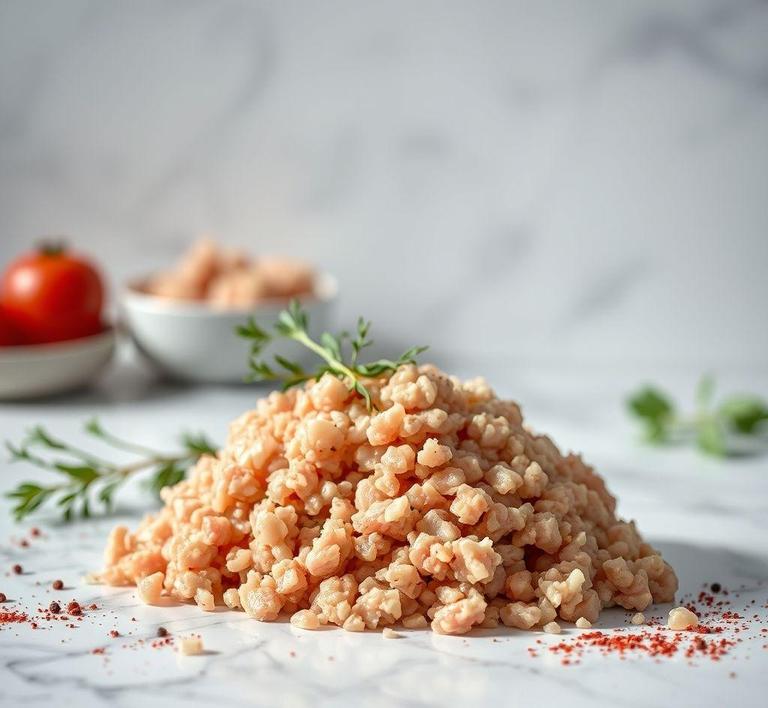Refreezing ground chicken is a topic that often comes with confusion, but with the right knowledge, it can be done safely and effectively. Whether you’ve thawed too much chicken for dinner or want to extend the shelf life of leftover meat, knowing the proper steps for refreezing ground chicken ensures that it stays fresh and safe to eat. In this guide, we’ll walk you through the key tips on how to properly refreeze ground chicken without compromising its quality or safety. From the timing to the best storage methods, this guide has you covered to make sure you’re handling your poultry correctly!
Can You Refreeze Ground Chicken?

Refreezing ground chicken is a question that often comes up when people are faced with leftovers or when they’ve thawed more chicken than they need. The short answer is yes, you can refreeze ground chicken, but there are some important considerations to ensure food safety and quality.
When ground chicken is thawed, it enters a period during which bacteria can start to multiply, especially if it has been sitting at room temperature for too long. The USDA recommends that any meat, including chicken, should not be left out at room temperature for more than two hours, and only for a maximum of one hour if the temperature is above 90°F (32°C). If the meat has been properly thawed in the refrigerator and has not been left out at room temperature for an extended period, it’s generally safe to refreeze it.
That said, there are factors to consider. Ground chicken, like all poultry, is prone to contamination because of its higher surface area and moisture content. If the chicken was thawed properly and never exceeded safe temperatures (below 40°F or 4°C in the fridge), refreezing is safe. However, there are some nuances that influence whether you should actually go ahead and do it.
How To Refreeze Ground Chicken?
If you’ve decided to refreeze ground chicken, following the correct process is key to maintaining its safety and minimizing the impact on its quality. Here’s a detailed guide on how to refreeze ground chicken properly:
1. Thawing The Chicken Properly First
Before you even think about refreezing, ensure that the ground chicken was thawed in a way that keeps it safe. The safest method is to thaw it in the refrigerator. This keeps the meat at a stable, cold temperature throughout the process, preventing the growth of harmful bacteria.
Alternatively, you can thaw the chicken in cold water or in the microwave, but these methods require more immediate cooking or refreezing afterward. If you thaw the chicken in the fridge, it can be kept for up to two days before needing to cook or refreeze.
2. Avoid Refreezing If Left Out Too Long
If ground chicken has been left out at room temperature for longer than two hours, the risk of bacterial growth increases significantly. In these cases, refreezing it isn’t a good idea, as bacteria that may have already started growing can survive the freezing process and thrive when the meat is later thawed. If you are unsure whether the chicken has been left out for too long, it’s best to discard it to avoid foodborne illness.
3. Portioning The Chicken
If you’re refreezing ground chicken that has already been thawed, consider portioning it into smaller, meal-sized amounts. This way, you can take out only the amount you need for future cooking, avoiding the need to refreeze the entire batch later. Using vacuum-seal bags or airtight freezer bags is ideal because they prevent freezer burn and help preserve the chicken’s quality.
4. Freezing Process
Place the ground chicken in an airtight, freezer-safe container or bag. Squeeze out as much air as possible to prevent freezer burn, which can affect the texture and taste. If you have a vacuum sealer, that’s your best bet for long-term storage.
Label the bag or container with the date of freezing so you can keep track of how long it’s been stored. Ground chicken should be used within 3-4 months for optimal quality, though it can be safe beyond that time if it’s stored correctly.
Quality Impact
While refreezing ground chicken is generally safe when done properly, it can have some impact on the quality of the meat. Freezing and thawing change the texture, moisture content, and flavor of the chicken, and the more times you freeze and thaw it, the more noticeable these changes become.
Texture
Chicken, especially ground chicken, has a fine texture that can become mushy or crumbly if frozen and thawed multiple times. The ice crystals that form during freezing can break down the muscle fibers, causing the chicken to lose moisture. When it’s thawed again, it can release that moisture, making the texture a bit more rubbery or dry. This is particularly true for ground meat, as it has a larger surface area and more exposed moisture compared to whole cuts.
Moisture Loss And Freezer Burn
Ground chicken is especially prone to freezer burn, which occurs when air is trapped in the container or bag during freezing, causing the surface of the meat to dry out and turn discolored. Freezer-burned chicken may have a dry, leathery texture, and its taste can become bland or “off”. To minimize freezer burn, ensure that the chicken is sealed tightly and that as much air as possible is removed before freezing.
Flavor
The flavor of ground chicken may also change after it’s been frozen and thawed multiple times. Freezing can cause some loss of natural flavors due to the breakdown of the fats and proteins during freezing. Additionally, any changes in texture, such as becoming drier or rubbery, can impact how the chicken cooks and tastes when reheated.
While the quality might be compromised with multiple freeze-thaw cycles, properly refrozen chicken can still be used in recipes where texture and moisture are less important, such as casseroles, soups, or stews.
While you can refreeze ground chicken if it has been thawed safely and not left at room temperature for too long, the process can have some effect on its texture, flavor, and overall quality. To safely refreeze ground chicken, make sure to thaw it properly in the fridge, portion it out, and use airtight packaging to preserve its freshness. While the safety risks are low as long as the chicken was handled correctly, it’s important to remember that refreezing can lead to changes in texture and flavor. The best practice is to avoid repeatedly freezing and thawing chicken, but when necessary, properly stored ground chicken can still be safe to eat after being refrozen-just expect a slight dip in quality.
Is It Safe To Refreeze Ground Chicken?
Refreezing ground chicken is a topic that often causes confusion among home cooks, and it’s important to understand both the science and the safety protocols behind it. The safety of refreezing ground chicken largely hinges on how the meat was handled throughout its lifecycle: from purchase to thawing, and finally, to refreezing.
In theory, ground chicken can be refrozen as long as it hasn’t been left at room temperature for too long or improperly stored. However, it is crucial to follow certain steps to minimize the risk of foodborne illnesses, such as salmonella or campylobacter, which are common in raw poultry. The general rule is that meat should only be refrozen if it has been thawed in the refrigerator, not on the counter, as thawing at room temperature can allow bacteria to proliferate. The longer ground chicken stays in the danger zone (40°F-140°F or 4°C-60°C), the higher the risk of contamination.
When you thaw chicken in the fridge, it stays at a safe temperature, generally below 40°F (4°C). If the chicken has been thawed in the refrigerator and hasn’t been sitting out at room temperature for extended periods, refreezing is typically safe. However, it’s important to remember that each freeze-thaw cycle can reduce the quality of the meat, especially in terms of texture, flavor, and moisture content. So, while refreezing is safe from a health standpoint (assuming proper handling), it might result in a less appetizing final product.
Signs That Ground Chicken Should Not Be Refrozen
When it comes to determining whether ground chicken should be refrozen or discarded, the key lies in how the chicken has been stored, how long it has been thawed, and what state it’s in when you’re considering refreezing. Here are the red flags that suggest ground chicken should not be refrozen:
- Unusual odor: If the ground chicken has a sour, rancid, or otherwise off-putting smell, it has likely begun to spoil. Meat that has been thawed and refrozen repeatedly is especially prone to developing unpleasant odors.
- Slimy texture: A slimy or sticky surface on ground chicken indicates bacterial growth and spoilage. This texture should raise an immediate alarm-refreezing meat in this state is dangerous and should not be done under any circumstances.
- Discoloration: If the chicken has turned a pale grayish-brown or has visible discoloration, it may be an indication that it has gone bad. Fresh ground chicken is typically a light pink color, so any substantial color change points to spoilage.
- Prolonged exposure to room temperature: If the chicken has been thawed at room temperature for more than two hours (or one hour if the ambient temperature is above 90°F / 32°C), it is no longer safe to refreeze. Bacteria multiply rapidly at room temperature, and any ground chicken left in the danger zone for too long must be discarded.
- Freezer burn: While freezer burn doesn’t mean that the meat is unsafe to eat, it does mean that the chicken’s quality has suffered significantly. If the ground chicken is covered in dry, whitish patches, it has been exposed to air in the freezer, which causes dehydration. Refreezing meat with visible freezer burn will result in a subpar taste and texture.
Common Refreezing Mistakes
While refreezing ground chicken can be done safely, there are some common mistakes that people make, which can lead to both safety and quality issues:
- Thawing chicken on the counter: One of the biggest mistakes people make is leaving frozen chicken out on the counter to thaw. Doing so allows the meat to warm up too quickly, bringing it into the temperature danger zone where bacteria can multiply. Always thaw ground chicken in the refrigerator or in a bowl of cold water to ensure it stays at a safe temperature.
- Refreezing after cooking: If ground chicken was initially cooked, refreezing after it has been fully cooked can be risky if it wasn’t handled properly. After cooking, it should be cooled to below 40°F (4°C) within two hours before being refrozen. If you let it sit out at room temperature too long or if it was not cooled down quickly enough, the chicken can harbor dangerous bacteria that can multiply during the refreezing process.
- Overloading the freezer: Freezing a large quantity of ground chicken at once can prevent it from freezing quickly, which allows for the formation of larger ice crystals. These crystals damage the meat’s cell structure and lead to a loss in texture and flavor. Instead, try freezing ground chicken in smaller portions to ensure it freezes evenly and quickly.
- Repeatedly thawing and refreezing: Each cycle of thawing and refreezing will degrade the quality of the chicken. Over time, this can result in dry, tasteless meat that lacks the moisture and tenderness it had when it was first frozen. To minimize these effects, try to only thaw and refreeze once.
Tips And Tricks
If you plan on refreezing ground chicken, here are some tips and tricks that will help you maintain both its safety and quality:
- Portion it out: Divide ground chicken into smaller portions before freezing it initially. This makes it easier to thaw only what you need, reducing the likelihood of having to refreeze larger portions. You can wrap each portion tightly in plastic wrap, then place it in a freezer-safe bag or container.
- Use airtight containers: Always use airtight packaging when freezing ground chicken. This will help prevent freezer burn, which affects both taste and texture. Vacuum-sealed bags are particularly effective in removing air, keeping the chicken fresh for a longer time.
- Label and date: Keep track of when the chicken was frozen so you can monitor how long it’s been in the freezer. Generally, ground chicken is best when used within 3-4 months of freezing.
- Quick thawing method: If you must thaw ground chicken quickly and are in a rush, you can use the cold water method. Place the chicken in a leak-proof plastic bag and submerge it in cold water, changing the water every 30 minutes. This method thaws meat safely, keeping it below 40°F (4°C).
- Do not refreeze raw chicken that was thawed in the microwave: When thawing in the microwave, the chicken may begin to cook in some areas, even if the rest of it is still frozen. This uneven thawing can cause bacterial growth, making it unsafe to refreeze.
- Cook before refreezing: If you have ground chicken that you don’t think you’ll use soon enough, consider cooking it and then refreezing it. This step helps maintain the texture and prevents bacterial growth, as long as the meat is properly cooked and stored afterward.
Conclusion
In conclusion, refreezing ground chicken is possible and can be done safely as long as certain precautions are followed. The key factors include ensuring the chicken has been thawed correctly (in the fridge, not at room temperature), avoiding prolonged exposure to the danger zone, and refraining from multiple cycles of thawing and refreezing. Paying attention to signs of spoilage such as bad odors, slimy texture, or discoloration is essential to ensuring the chicken remains safe to consume.
Refreezing mistakes like thawing chicken on the counter or overloading the freezer can significantly degrade the quality of the meat, so it’s best to avoid those common pitfalls. With the right storage methods, portioning, and a little extra care, you can safely refreeze ground chicken while maintaining its best possible quality.


